

Other stumbling blocks to the modern reader are the poet’s classical and Biblical allusions, rarely identified since Dante expected his readers to recognize them.


As Frisardi warns us, Dante draws on a vocabulary that is Aristotelian in origin but modified by Christian philosophy from Augustine through Aquinas, a vocabulary as foreign to the modern reader as are the special meanings of the topics it discusses: substance and accident (or the unchanging and the contingent), anger and pride (two of the seven deadly sins), intellect (or a pure awareness of Being), and so on. Much of the Vita Nuova might seem almost artless if we had not read Frisardi’s extensive, detailed, and satisfying notes, which draw on the major editions, commentaries, and critical works in Italian as well as in English, and also venture conclusions of Frisardi’s own. The “fit” between the narrative and the poems is consequently uneasy: Beatrice is already dead when the prose narrative begins, but as Dante recollects his youth the “inserted” poems themselves record the ongoing life-chronology of love followed by mourning. Only a few years later-after Beatrice had died and Dante had undertaken the study of philosophy-was the frame-story written to surround those earlier lyrics. But this appearance of the book is deceiving: the poems were in fact written first, beginning when Dante was eighteen. The narrative as a whole tells of the poet’s attachment to the lady Beatrice, and the poems, as printed, appear to be responses to, or illustrations of, the narrative. Dante’s book, composed not in the expected Latin but in Italian, consists of a retrospective “frame-story,” introducing, with short prose narratives and analytical remarks, each of its thirty-one lyrics (which are mostly sonnets, but include three long canzoni, or songs). Boethius’s successive prose pieces undertake a sustained dialogue on moral questions with Lady Philosophy, while his interspersed lyrics (varying in form) include exhortations, stories, hymns, prayers, and lamentations. The form was popularized by the sixth-century philosopher Boethius’s Latin work called The Consolation of Philosophy, but Dante’s “little book” (as he called it) could hardly be more different from Boethius’s compendium. (I depend on Frisardi’s scholarly Introduction and Notes for some of what follows.) The Vita Nuova is a “prosimetrum”-a work in which prose alternates with poetry. Andrew Frisardi’s new translation of the Vita Nuova, finely introduced and closely annotated, is a book intended for the general reader who wants to understand the intricacy of Dante’s early undertaking in the deceptively “open” poems of the sequence. We have a fairly solid idea of how Dante ended up, but most of us have a vague notion of how he began.


 0 kommentar(er)
0 kommentar(er)
